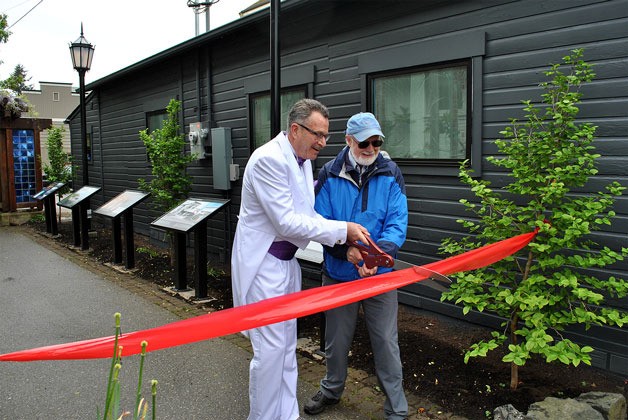By LORINDA KAY
For The Record
A walk down Frick Lane in Langley now offers a step back in time to the history of the town’s beginnings.
More than a year in the making and after hundreds of hours of volunteer labor, the Langley History Walk is now ready for viewing. A celebration was recently held with Mayor Tim Callison cutting the ribbon at the tiny lane off First Street.
Set between the Moonraker Bookstore and the Artisan Crafted Home building (formerly The Heron) a pictorial display of Langley’s history was created to help residents and visitors appreciate the city’s past. The project was completed in April by the Langley Main Street Association under the direction of Robert Waterman, who has a passion for preserving the town’s history.
Waterman is a board member and the design committee chairman for Main Street, the chairman of the Langley Historic Preservation Commission, a past president of the South Whidbey Historical Society and co-authored the history book “Images of America, Langley” with Frances Wood. He has organized and written several presentations for the public, including a show presented at WICA, “Langley Life: 1890 – 1980” that depicted Langley’s living history through the eyes of long-time Langley resident Walter Hunziker.
Waterman and Main Street also created the history plaques located on several buildings in Langley. The Frick Lane display continues the preservation of the story with five panels, each with a photo and a brief history from a vast collection of images Waterman has gathered from the South Whidbey Historical Society.
Several displays are a composite photo of then and now, crafted with the technical help of Rich Frishman, a nationally renown photographer who lives in Langley and, luckily, right next door to Waterman. Each panel describes a place in time from “A Town is Born,” with a 1910 photo of the charred remains of the store built by town founder Jacob Anthes, the hotel fire of 1921 and the Olympic Club — now known as the Dog House — to the marina composite photo from 1918 to 2014. Another panel shows the first female mayor, Helen Coe, and her all-woman council from 1920.
“This was a real community effort,” Waterman said. “It was a culmination of support from a large number of people.”
The original concept for the History Walk came to Waterman from Debra Waterman (no relation) who saw an outdoor historical display in Salmon, Idaho and wanted to have something similar in Langley. After searching for a suitable location, he determined Frick Lane could serve two purposes: to brighten-up and beautify the area and to preserve Langley’s history.
The project began in the spring of 2015 with the removal of old trees in the lane that were stunted from too much pruning. Waterman then painted the two building sides facing the lane and created a design for the walkway, which included the addition of two antique lamps that were brought to Langley from California by the LaRue family in the early ‘70’s. One lamp was already placed at Boy & Dog Park many years ago. When the opportunity came to purchase the two remaining lamps from Virginia LaRue’s estate, Main Street Board Member Sandra Jean Wainwright jumped at the opportunity.
The blue glass and wood archway at the south end of the lane was sanded and the lights inside replaced to restore the iconic landmark and add illumination to the lane. Poles for the lamps were purchased and painted, an electrical box and timer installed for the lamps and additional outlets, and the five panels purchased.
The total price tag of the project was $13,350, though the figure does not include donated labor.
Work began with the digging of trenches for the electrical lines with help from Ben Courteau and Waterman. Extensive concrete bases for the panels and lamps were installed by Kirk Highberger of Highberger Construction; he donated all his labor and much of the material. Additional volunteer help was provided by Fred Lundahl. Wiring and lifting the lamps in place and installing the panels was completed with the help of Steve Saltee and Don Denman. Cathy Rooks planted three Stewartia trees and created a plan for more low-growing plants to enhance the lane, funded by a grant from the South Whidbey Garden Club.
“It was a long project,” Waterman said. “Once the panels were in place I was surprised and gratified by the number of people who stopped and read the panels and the knowledge they gained.”
Remembering the town’s history is crucial to Waterman, who has spent his retired life in Langley pursuing and preserving the history.
“Every older building tells us something about the previous history of the town. When we lose a bit of our history it becomes easier to forget those who came before us,” Waterman said.
The first outdoor history display in Langley is now ready for viewing. The panels allow for the displays to be changed, so new images can be added in the future. Once Puget Sound Energy connects the electricity, the light will illuminate the lane. Plants will be added this spring to complete the improvements.



